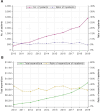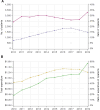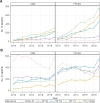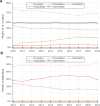Trends of Korean medicine service utilization for lumbar disc herniation and spinal stenosis: A 10-year analysis of the 2010 to 2019 data
- PMID: 39058889
- PMCID: PMC11272331
- DOI: 10.1097/MD.0000000000038989
Trends of Korean medicine service utilization for lumbar disc herniation and spinal stenosis: A 10-year analysis of the 2010 to 2019 data
Abstract
This retrospective, cross-sectional, and descriptive study aimed to analyze the trend of utilizing traditional Korean medicine services in patients with lumbar disc herniation (LDH) and/or lumbar spinal stenosis (LSS). In this study, based on the national patient sample data provided by Health Insurance Review and Assessment Service (HIRA), the trend of Korean medicine service utilization was investigated, including the following information: demographic characteristics of the patients, the total expenditure, number of claim statements per category, medical care expenditure per category, and routes of visiting traditional Korean medicine institutions. The study population comprised patients who visited Korean medicine institutions at least once from January 2010 to December 2019, with LSS and LDH as the primary diagnosis. LDH patients who used traditional Korean medicine services for treatment increased by about 1.36 times. LDH and LSS patients under 45 years of age were more likely to be males, but women accounted for a higher percentage among those over 45 years of age. Overall, women accounted for a slightly higher percentage than their counterparts for both diseases. From details of treatments received that were extracted from the claims data, acupuncture treatment accounted for the highest percentage for both disorders. Moreover, 50.7% of the patients who visited Korean medicine institutions to treat the two diseases also visited conventional Western medicine institutions. These patients, who were diagnosed with their condition at a Korean medicine institution, visited a conventional institution and then returned; the conventional institutions were primarily used for examination (40.5%). Increased utilization of traditional Korean medicine services was confirmed among patients with LDH and/or LSS; in particular, a sharp increase was noted among patients with LSS. The results of this study will be useful as basic research data for clinicians, researchers, and policy makers.
Copyright © 2024 the Author(s). Published by Wolters Kluwer Health, Inc.
Conflict of interest statement
The authors have no conflicts of interest to disclose.
Figures





References
-
- Deyo RA, Weinstein JN. Low back pain. N Engl J Med. 2001;344:363–70. - PubMed
-
- Lee JH, Moon J, Lee SH. Comparison of effectiveness according to different approaches of epidural steroid injection in lumbosacral herniated disk and spinal stenosis. J Back Musculoskelet Rehabil. 2009;22:83–9. - PubMed
-
- Jensen MC, Brant-Zawadzki MN, Obuchowski N, et al. . Magnetic resonance imaging of the lumbar spine in people without back pain. N Engl J Med. 1994;331:69–73. - PubMed
-
- Watters WC, 3rd, Baisden J, Gilbert TJ, et al. . Degenerative lumbar spinal stenosis: an evidence-based clinical guideline for the diagnosis and treatment of degenerative lumbar spinal stenosis. Spine J. 2008;8:305–10. - PubMed
MeSH terms
LinkOut - more resources
Full Text Sources
Medical

